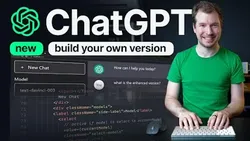
Lets Build ChatGPT 20 with React JS and OpenAI on your PC! 
This course teaches participants how to build a ChatGPT 2.0 with React JS and OpenAI on their own PC. It covers topics such as coding a ChatGPT preview, setting up an OpenAI Template Starter Kit, initialising the project, starting the frontend with Create React App, and designing and styling the ChatGPT Side menu. Participants will gain the skills to create their own ChatGPT 2.0. ▼
ADVERTISEMENT
Course Feature
![]() Cost:
Cost:
Free
![]() Provider:
Provider:
Youtube
![]() Certificate:
Certificate:
Paid Certification
![]() Language:
Language:
English
![]() Start Date:
Start Date:
On-Demand
Course Overview
❗The content presented here is sourced directly from Youtube platform. For comprehensive course details, including enrollment information, simply click on the 'Go to class' link on our website.
Updated in [February 21st, 2023]
- Introduction
- Coding ChatGPT preview
- OpenAI Template Starter Kit
- ChatGPT Starter Kit
- Initialising Project
- Starting Frontend with Create React App
- Designing ChatGPT Side menu
- Styling ChatGPT Side menu
- Designing Prompt Input
- Styling Chat GPT Input
- Coding Chatbot Interface
- Styling the Chat message interface
- Adding OpenAI SVG Logo
- Starting Backend with Express
- Preparing OpenAI Configuration and API Key
- Creating Express API Routes
- React Frontend handle Submit function
- Cleaning up the React Components
- Creating Frontend API Request using Fetch
- Frontend Backend integration
- Adding Features to Select OpenAI Models
- Conclusion
(Please note that we obtained the following content based on information that users may want to know, such as skills, applicable scenarios, future development, etc., combined with AI tools, and have been manually reviewed)
This course provides an introduction to developing a conversational chatbot using the OpenAI Template and ChatGPT Starter Kit. Students will learn how to initialise a project, design the chatbot interface, create Express API routes, React frontend handle submit functions, make backend API requests, and integrate the frontend with the backend. They will also learn how to add features to select OpenAI models. Upon completion of the course, students will have an understanding of OpenAI configuration and the API key, and will have created a fully functioning chatbot.
[Applications]
Upon completion of this course, students should be able to apply the knowledge they have gained to create their own chatbot using React JS and OpenAI. They should be able to configure the OpenAI API key, design the chatbot interface, create Express API routes, and integrate the frontend with the backend. Additionally, they should be able to add features to select OpenAI models.
[Career Paths]
1. Chatbot Developer: Chatbot developers are responsible for designing, developing, and deploying chatbots for various applications. They must have a strong understanding of natural language processing (NLP) and machine learning (ML) algorithms, as well as the ability to create user-friendly interfaces. As the demand for chatbots continues to grow, so does the need for experienced chatbot developers.
2. AI Engineer: AI engineers are responsible for developing and deploying AI-based solutions. They must have a strong understanding of AI algorithms, as well as the ability to develop and integrate AI-based solutions into existing systems. As AI technology continues to evolve, so does the need for experienced AI engineers.
3. Machine Learning Engineer: Machine learning engineers are responsible for developing and deploying machine learning models. They must have a strong understanding of machine learning algorithms, as well as the ability to develop and integrate machine learning models into existing systems. As machine learning technology continues to evolve, so does the need for experienced machine learning engineers.
4. Natural Language Processing Engineer: Natural language processing engineers are responsible for developing and deploying natural language processing (NLP) models. They must have a strong understanding of NLP algorithms, as well as the ability to develop and integrate NLP models into existing systems. As NLP technology continues to evolve, so does the need for experienced NLP engineers.
[Education Paths]
1. Bachelor of Science in Computer Science: This degree path focuses on the fundamentals of computer science, such as programming, algorithms, data structures, and software engineering. It also covers topics such as artificial intelligence, machine learning, and natural language processing. This degree path is ideal for those interested in developing chatbots and other AI-based applications.
2. Master of Science in Artificial Intelligence: This degree path focuses on the development of AI-based applications, such as chatbots, virtual assistants, and autonomous vehicles. It covers topics such as machine learning, natural language processing, computer vision, and robotics. This degree path is ideal for those interested in developing advanced AI-based applications.
3. Master of Science in Data Science: This degree path focuses on the analysis and interpretation of large datasets. It covers topics such as data mining, machine learning, and predictive analytics. This degree path is ideal for those interested in developing data-driven applications, such as chatbots and virtual assistants.
4. Doctor of Philosophy in Artificial Intelligence: This degree path focuses on the development of advanced AI-based applications. It covers topics such as machine learning, natural language processing, computer vision, and robotics. This degree path is ideal for those interested in developing cutting-edge AI-based applications.
Course Provider

Provider Youtube's Stats at AZClass
Discussion and Reviews
0.0 (Based on 0 reviews)
Explore Similar Online Courses

Startup Library: Knitting

Explorations in Brioche Knitting

Python for Informatics: Exploring Information

Social Network Analysis

Introduction to Systematic Review and Meta-Analysis

The Analytics Edge

DCO042 - Python For Informatics

Causal Diagrams: Draw Your Assumptions Before Your Conclusions

Whole genome sequencing of bacterial genomes - tools and applications

React Basics Course

JavaScript: Functions


Start your review of Lets Build ChatGPT 20 with React JS and OpenAI on your PC!